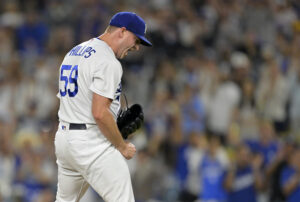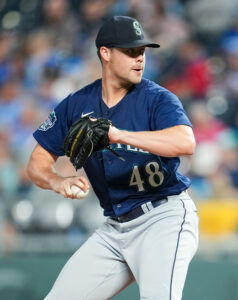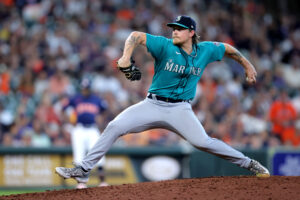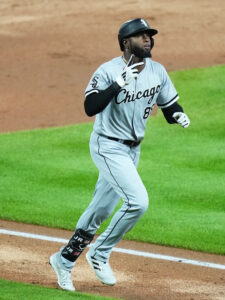With the regular season winding down, a number of teams (and their fanbases) are already starting to turn their attention towards the offseason. Identifying free agent targets is a big part of that prep work, so it’s worth taking an early look at the players who’ll be available on the open market.
Over the coming weeks, MLBTR will go around the diamond to preview the free agent class. As always, we’ll start behind the plate. It’s a thin group, with no one in the class a threat to approach the five-year, $87.5MM contract that Willson Contreras received a season ago.
Note: only players who have been on an MLB roster in 2023 are included for this exercise.
Potential Regulars/Platoon Options
- Mitch Garver (33*)
Garver could prove a tricky evaluation for teams. He’s having the best season of any impending free agent who can catch. The right-handed hitter is mashing at a .286/.387/.541 clip with 16 home runs over 270 plate appearances for the Rangers. He slugged 31 homers for the Twins back in 2019 and is a career .254/.343/.489 hitter. A fully healthy Garver is one of the best offensive catchers in the sport and easily the best player in this winter’s free agent catching class.
Fully healthy is a notable caveat, however. Not only will Garver turn 33 this winter, he has a lengthy injury history. He has spent some time on the IL in every season since 2019 and required season-ending surgery to repair a torn flexor tendon in 2022. That injury affected Garver’s throwing even before he went under the knife, and Texas has eased him back to catching action. He has logged only 230 innings behind the dish this season, seeing more time as a designated hitter. The Rangers have that luxury thanks to the presence of All-Star backstop Jonah Heim, but it raises questions for teams evaluating whether Garver will hold up as a true #1 elsewhere.
- Gary Sánchez (31)
Sánchez has never returned to his early-career Yankees form. He’s nevertheless coming off a decent bounceback showing for the Padres, hitting .218/.292/.500 with 19 homers through 260 plate appearances after landing in San Diego. His much-maligned blocking drew an average grade from Statcast this season, while he threw out baserunners at an acceptable 20.8% clip. The year ended on a sour note when Sánchez sustained a right wrist fracture on a hit-by-pitch last week, but it was a reasonably encouraging effort overall.
While he’s not a star, Sánchez looks like an acceptable #1 catcher. He’s a power-first offensive player with middling on-base marks. One of the younger players in the class, he has a case for a multi-year contract after settling for a minor league pact a season ago.
- Tom Murphy (33)
Murphy has mashed in a small sample this year, hitting .290/.335/.538 over 159 plate appearances. He has shown significant offensive upside in prior seasons — highlighted by a .273/.324/.535 line over 76 games in 2019 — but only has two years in which he has reached 200+ plate appearances. Murphy lost all of 2020 with a foot fracture, a good chunk of last season to a dislocated shoulder, and has been out for the past month with a sprained left thumb.
When healthy, he consistently shows plus power from the right-handed batter’s box. He strikes out a lot but brings more offensive upside than most players at the position. At age 33, he’ll be limited to one or two-year offers, but he should be a target for teams that can pair him with a more stable veteran to compensate for the injury risk.
- Víctor Caratini (30)
Caratini is a switch-hitting backstop with good strike zone awareness and solid contact skills. He hits the ball reasonably hard but makes most of his contact on the ground, muting his power impact. This year’s .247/.327/.368 line over 54 games for the Brewers is in line with his career track record. He rates as a decent pitch framer but has a well below-average throwing arm. While Caratini doesn’t have a standout skill, he’s a reasonably well-rounded player and the youngest option in the catching class.
- Yasmani Grandal (35)
Grandal was still performing at an All-Star level as recently as 2021. The final two years of his $73MM free agent deal with the White Sox didn’t go as planned. He limped to a .202/.301/.269 line last season and is hitting .236/.309/.345 over 388 plate appearances this year. He’s a switch-hitter who still draws a decent number of walks, but he hasn’t shown the same kind of power he had at his peak.
- Austin Hedges (31)
Hedges is an all-glove veteran who has found semi-regular run despite one of the league’s least imposing offensive profiles. He was an everyday catcher for three years in Cleveland and got into 65 games for the Pirates after signing a $5MM free agent deal last winter. The Rangers have pushed him into a depth role since acquiring him at the deadline.
The 31-year-old is hitting .176/.229/.222 through 203 plate appearances. He has had a hard time controlling the running game this season but has been excellent in that regard in prior years. Hedges’ elite receiving skills have not waned. Statcast rates him 11 runs above average as a pitch framer and credits him with eight more blocks than average. That’s in line with his career-long reputation as an elite receiver, and both Cleveland and Pittsburgh trusted him as their top catcher to work with fairly young pitching staffs.
- Martín Maldonado (37)
Maldonado is a beloved clubhouse presence in Houston. The Astros have continued to give him a starting workload on a World Series contender despite dismal offensive numbers, reasoning that his unquantifiable work with the pitching staff compensates for the lack of productivity at the dish. Maldonado has hit only .187/.254/.337 through 366 trips to the plate. He has occasional power but consistently poor on-base marks. Unlike Hedges, Maldonado has a well below-average grade from Statcast for his 2023 pitch framing. It hasn’t dissuaded Dusty Baker from keeping him in the lineup, though — a testament to how the coaching staff feels about his leadership and game-calling acumen.
Backups/Depth
- Jorge Alfaro (31)
A longtime top prospect who was a key piece in multiple blockbuster trades (Cole Hamels, J.T. Realmuto), the now-30-year-old Alfaro (31 next June) has never developed into the slugger that many expected. Alfaro posted a solid .269/.322/.429 batting line from 2017-19, but in 737 plate appearances since that time he’s at .236/.278/.354 with a glaring 33.6% strikeout rate. Alfaro has typically thrown well (28% caught-stealing rate), but he’s at 18% in Triple-A this year. Statcast grades him last among 75 qualified catchers since 2018 when it comes to blocking pitches in the dirt.
- Tucker Barnhart (33)
Barnhart has spent the past week in Triple-A with the Dodgers. He signed a minor league pact with L.A. after being released by the Cubs in the first season of a two-year, $6.5MM free agent deal. The two-time Gold Glove winner managed only a .202/.285/.257 line over 123 plate appearances with Chicago and is a .215/.286/.264 hitter since being traded from the Reds to the Tigers over the 2021-22 offseason. Despite the tepid offense, Barnhart should draw depth interest based on his glove and reputation as a strong clubhouse presence — especially since the Cubs are responsible for all but the league minimum on next year’s salary as well.
- Curt Casali (35)
The Reds are likely to opt for a $750K buyout on their end of a $4MM mutual option. The right-handed hitting Casali has operated as the third catcher in Cincinnati when healthy, batting .175/.290/.200 over 96 plate appearances. He is currently on a rehab stint working back from a July foot contusion.
- Sandy León (35)
León, currently in Triple-A with the Guardians, appeared in 22 games for the Rangers early in the season. The switch-hitting backstop is a classic journeyman depth catcher. He has gotten to the majors in each of the past 12 years. He’s a well-regarded defender who has hit .176/.254/.261 for five teams since the start of 2019.
- Luke Maile (33)
Maile signed a $1.175MM free agent deal with his hometown Reds last winter. He has essentially played at the level they’d expected as their backup, putting up a .234/.305/.392 line through 175 plate appearances. He has roughly average framing and blocking numbers and has cut down a quarter of opposing basestealers. He has probably done enough to secure another major league contract this offseason.
- Roberto Pérez (35)
Pérez won consecutive Gold Glove awards in 2019-20. He has continued to get looks based on his defense, but injuries have kept him off the field for most of the last two seasons. He suffered a season-ending hamstring tear in May 2022. He was capped at five games with the Giants this year before tearing the rotator cuff in his throwing shoulder, necessitating another surgery in April. He’ll likely be limited to minor league offers as a result.
- Manny Piña (37)
Piña had a few seasons as a productive depth option with the Brewers. Unfortunately, left wrist issues have essentially robbed him of the last two years. He underwent surgery after just five games in 2022. Piña started this year back on the injured list with continued soreness. He returned for four games this summer but Oakland released him around the trade deadline as they evaluated their younger catching options.
- Mike Zunino (33)
Zunino signed a $6MM contract with the Guardians a year ago on the heels of thoracic outlet surgery. He couldn’t recapture his pre-surgery form on either side of the ball. Zunino hit .177/.271/.306 with a 43.6% strikeout rate in 140 plate appearances. Perhaps even more concerning was that he struggled mightily as a receiver and threw out only 16.7% of baserunners. Cleveland released him in late June and he has remained a free agent since then.
Club Options
- Yan Gomes (36)
The Cubs hold a $6MM option that comes with a $1MM buyout. It’s a $5MM call, which seems reasonable after Gomes’ decent 2023 showing. The 12-year MLB veteran is hitting .269/.311/.414 with nine home runs through 360 trips to the plate. He hasn’t rated highly for his receiving but has thrown out an above-average 26.4% of attempted basestealers. The Cubs may look to turn the top catching job over to rookie Miguel Amaya, but it’s a low enough price point that the team could still retain Gomes as a veteran backup.
Player Options
- Omar Narváez (32)
Narváez is unlikely to hit free agency. His contract with the Mets contains a $7MM player option. The left-handed hitter has slumped to a .192/.272/.253 line in 39 games, missing a chunk of the year with a calf strain. Unsurprisingly, he told Will Sammon of the Athletic last month that he expects to exercise the option rather than retest free agency on the heels of such a tough season.
* Listed ages are the player’s age for the 2024 season.




